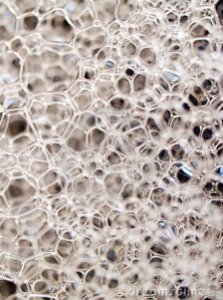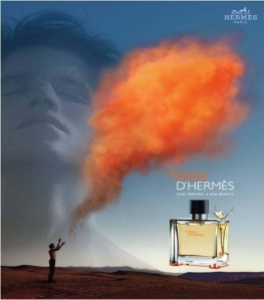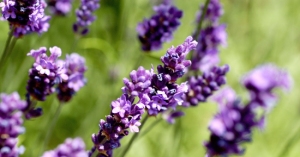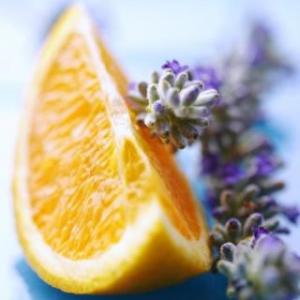Deep in the heart of the forest, where the sun never shines, there is a campfire surrounded by mighty trees. All around it, as far as the eye can see, there is vetiver forming a peaty, green carpet. It clambers up the trees, covering even the branches with a vista of green. In that clearing, though, the smoke burns as black as a panther, smelling of both the piney trees around it and of incense. Tarry and leathered, it merges with the vetiver to send a smoke signal up to the sky, announcing the arrival of “dark shadows.” But this is not Joseph Conrad’s Heart of Darkness and you should not be fooled by what’s on the surface. If you peer really hard, you can see small spots of colour: cloved umber, patchouli brown, mint, honeyed yellow, iris grey suede, and soapy white. It’s Sombre Negra.
Sombre Negra (“Dark Shadow”) is an eau de parfum from the San Francisco perfumer, Yosh Han. Sombre Negra was the first in her darker line of perfumes called “M,” and has a very confusing history. It was initially a limited-edition fragrance created in 2010 exclusively for Luckyscent, and centered around dark, mushroom notes like “choya loban,” teak, cypress, vetiver and tobacco.
Then, in 2011, she made a second version that she reportedly called “M:001 Sombre Negra.” It’s completely unclear to me whether this version is also exclusive to Luckyscent. Reading Luckyscent’s description very carefully and with literal interpretation, one might think it was and that there were still two versions out there. It doesn’t help that the description for Sombre Negra on some other U.S. retailers (like Barney’s) references the old notes. I emailed Ms. Yan a few days ago to obtain clarification on the issue, but have not yet received a response.
To me, it simply doesn’t make sense that the new version remains a Luckyscent exclusive, or that there continues to be two different perfumes with the same name. Everyone who has tested Sombre Negra from late 2011 onwards seems to be talking about the second Version 2.0 with its different notes and smell. Moreover, Yosh fragrances are carried throughout Europe, and I highly doubt all the European perfumistas who talk about the new, more patchouli and clove-centered fragrance are universally obtaining their samples from Los Angeles’ Luckyscent.
So, I’m going to assume that Version 2 has completely replaced the original, limited-edition 2010 Luckyscent exclusive. You should too, but be aware that any discussions of Sombre Negra dated before the end of 2011 are referencing a very different fragrance, one that was reportedly much darker, earthier and smokier. This review is for the new, updated post-2011 version. [UPDATE 2/3/14 – Ms. Han has confirmed that all the vendors currently selling Sombre Negra, whether in Europe or America, are selling the new version. “Lucky Scent was the only retailer to carry the original. The M:001 version is available to everyone.”]
Yosh’s website has no individual page for Sombre Negra that I can quote for its (current) description or notes, so we have to rely on Luckyscent‘s old entry:
Please note, this is a newly re-imagined Sombre Negra.
Perfumer Notes: ”I launched a Limited Edition Sombre Negra exclusively with LuckyScent in 2010. That fragrance to me was dark and edgy. Very dense. I wanted to explore the idea of shadows and their mutations so I decided to create a new edition of Sombre Negra. The new M:001 Sombre Negra incorporates citrus top notes that reflect a flash of lightening – a spark of fire that quickly vanishes but casts new and elongated shadows. Rose, tonka and orris were added to give it some depth and fullness. Nutmeg and cumin give the fragrance a kind of vegetative musk and suede element to an otherwise smokey and leathery fragrance. It is still very masculine but Sombre Negra is also the ‘boyfriend fragrance’ that women are falling in love with and keeping for themselves.[Notes]: Vetiver, patchouli, cedar, olibanum, pink pepperberry and black peppercorn, clove, juniper, citrus, nutmeg, cumin, tonka and orris root.
I think Sombre Negra‘s opening is absolutely fantastic. It is a sinewy, hefty, opaque burst of peaty vetiver, campfire smoke, cloves, honey, and pepper. Trailing behind is an utterly mesmerizing, perfectly balanced, tarry aroma that is simultaneously fresh, piney, resinous, and infused with birch tar smoke. I wouldn’t be surprised if the “juniper” note in the listing were really a reference to cade oil, which is a distillation of the prickly juniper and has a particularly smoky, phenolic character. Whatever the source of the tar, I love how it plays off the peaty vetiver and the smoke.
That smoke, that smoke… my God, it’s beautiful. It’s exactly like the smell that you’d get from a campfire outdoors, but there is also incense in there as well. What makes it my favorite part of the fragrance is the way it has the most minuscule drop of honey in it, along with tobacco and leather facets. I’m guessing that those are the indirect result of the patchouli which pops its head up 5 minutes into Sombre Negra’s development. Initially, it is a subtle note that is more woody, sweet, and tobacco-like than green, but traces of the patchouli’s mentholated side are skulking around in the corners.
The whole thing is utterly glorious, and feels like a distant, non-floral, 5th cousin removed from Amouage‘s Tribute Attar. They have the same fantastic smokiness, though the Sombre Negra is more complex than an attar centered around incense and rose. Yet, Sombre Negra has its own floral component, too. The iris appears after 7 minutes, though it is a dry, rooty kind. There seemed to be a brief pop of rose, too, but both flowers are quickly overshadowed by the mint note that bursts on the scene. Whether it stems from a fresh, Haitian kind of vetiver or from the patchouli, I have no idea, but the wintergreen doesn’t really seem to fit in for me.
Sombre Negra is becoming smokier, darker, and more leathered with every minute. Its tarry blackness has a distinct oily quality to it, perhaps from the undiluted, pure patchouli. Visions of oil slicks and the La Brea tar pits float around my head, alongside the image of that campfire deep in the heart of a vetiver forest. There is a muted pop of yellow from a lemon, but it’s gone in an instant. Much more noticeable, however, is the growing influence of the clove which lends big splotches of brown-umber to the colour palette. It’s spicy, deep, but also smooth and warm, and it works beautiful with the patchouli. Unfortunately, at this point in the game, the patchouli isn’t my favorite sort with its chewy, toffee’d, spiced, sweet, smoky brownness, but a very green kind. Not even the cloves can counter the growing presence of slightly camphorated mintiness that is wafting off my arm.
As a whole, Sombre Negra in the opening 10 minutes is a panoply of somber, dark elements, just as the name suggests, but I find a playfulness underlying it. I haven’t the foggiest notion of why. All I can say is that Sombre Negra feels like an oddly cheerful, whimsical take on blackness. Perhaps it is due to the spicy warmth of the cloves, mixed with the touch of honey (where is it coming from?!) and the dangling, distant suggestion of some sweetened warmth.
It only takes another 5 minutes for the perfume to turn smoother and softer, as the more intense elements are slowly tamed. The cloves grow stronger, but there is also a hint of powder that starts to flit about. The tobacco, tarry, and oily elements retreat, the iris steps forward, and the green patchouli moves to stand next to the vetiver on center stage. The menthol and mint remain, but, to my sadness, that beautiful, honey-tipped campfire smoke is slowly dissipating and thinning out. So is the peaty quality of the vetiver. Soon, Sombre Negra’s primary bouquet is a green vetiver-patchouli duo, infused by cloves, light cade smoke, faintly powdered sweetness, and iris.
The smoke is now a thin tendril that ties all the elements to each other, instead of that dense, deep, powerful wall of Sombre Negra’s start. It’s all lovely, but it isn’t quite as spellbinding as the opening minutes with its multi-faceted complexity. However, the thinner, reduced amount of smokiness will probably be a very good thing for most people, as I suspect some may find the opening 10 minutes difficult if they’re not accustomed to that degree of blackness. Certainly, Sombre Negra is a more approachable, moderated scent after 40 minutes as a whole, and it just gets mellower with every passing half hour. I’m not so enthused about that, but then, I’m someone who adores the intensity of Amouage’s Tribute.
There are subtle changes that begin to occur after Sombre Negra’s forceful beginning. 30 minutes in, the sillage drops, the perfume lies an inch above the skin, and Sombre Negra feels much thinner, though it is still very rich when smelled up close. 40 minutes in, the traces of leather that were so noticeable in the beginning now lurk only on the periphery. Instead, an iris-driven suede starts to become very noticeable. It’s all very pretty and soft, a nice addition to the vetiver-patchouli with its mint and quiet campfire smoke. Then, alas, 70 minutes in, Sombre Negra turns into a skin scent. If I dab on a lot, I can push that time frame to a little over 90 minutes, but Sombre Negra never projects much on me. I have to wonder what would happen if I had a spray sample, as aerosolisation definitely increases sillage.
Skin chemistry is key in all this and, as you will see later, I’m not the only one who thinks that Sombre Negra may be wildly different depending on how your skin handles particular notes. It explains my greatest problem with Sombre Negra’s second stage and subsequent development. I’ve noticed that, on occasion, my skin takes vetiver — at least the fresh, green kind that is usually the Haitian sort of vetiver — and runs with it. The note becomes amplified to the detriment of much else around it, overpowering the other elements, and changing what is (on everyone else’s skin) a more balanced creation. I think that is the case here with Sombre Negra because, for the majority of its lifespan, the fragrance is green vetiver first and foremost, from top to bottom. Other elements exist, fluctuating in various degrees over the next few hours, but few of them are in proportion or change the primary vetiver bouquet. Either way, it’s a green show, not a black, smoky one. I’m rather crushed.
The one exception to the “Vetiver Supercedes All” situation is the olibanum or myrrh. Unfortunately, here again, we have another note that my skin handles oddly. On most people, olibanum translates as the smell of incense, though a cool, white sort of smoke that is usually described as “High Church.” On my skin, however, 8 out of 10 times, olibanum/myrrh = soap. Pure soap. And I am not a fan of soapiness…. With Sombre Negra, the myrrh first pops up 2.5 hours in as a subtle soapiness, and it just grows from there. Meanwhile, the patchouli fades away, the cloves retreat to the sidelines, and the iris’ suede and powder tonalities become these ghostly things that only occasionally pop up to chirp “hello.” Unhappily for me, the mint remains, which may be merely another side of the vetiver or it may stem from the patchouli. As a whole, Sombre Negra becomes a thin, gauzy blend of vetiver, followed by mint, olibanum soap, and cade campfire smoke.
It becomes even simpler from there. At the end of the 4th hour, Sombre Negra is primarily vetiver with a little soapiness and campfire smoke. At the start of the 6th hour, it is soapy vetiver and there it remains until its very end when it finally fades away as an abstract, nebulous sort of woody cleanness. All in all, Sombre Negra lasted just under 12 hours on my skin, with the majority of its time as vetiver with soapiness. If you’re one of those people for whom olibanum manifests as actual smoke, then you can read that as “vetiver incense” instead. I was not so fortunate.
The skin-determinant issue of the vetiver is something that was noted by another blogger as well. My friend, the sultry Victoria of EauMG had a similar experience with Sombre Negra. Her review reads, in part:
Sombre Negra smells pitch black, smoky, and caliginous. [¶] Sombre Negra opens as a smoky vetiver with earth. The smoky vetiver and slightly damp earth/mushrooms are held together by warm, masculine spices. It really is both damp and dry; I find this interesting. Soon an animalic leather appears that reminds me a little of the base of Tom Ford Tuscan Leather. It’s a mossy, cade leather. The leather is bound to the vetiver with masculine, overcast spices. The dry-down is dark, masculine, spicy with tonka and leather. […][¶]
I really recommend wearing this on the skin (I do with all scents, but especially with this one). On my skin, the vetiver is very pronounced and the rest is incense and leather. I seriously get vetiver from top to bottom. On others they seem to be getting more patchouli or woods. I think all versions sound good, but this one really seems to adapt to the wearer’s skin.
Sombre Negra has above average projection and longevity.
For The Scentualist, Sombre Negra is one of those fragrances that isn’t for the masses, but one which he finds to be an enchanting, dark delight that has become his second favorite incense fragrance. His positive review reads, in part:
Sombre Negra shines with a double personality, being at the same time ubiquitous and ethereal, two features that are not at hand for the majority of olfactory creations.
From the first moments subsequent to spraying some whiffs of Sombre Negra onto my wrist, I was able to detect a beguiling aroma of smoke (due to incense), juxtaposed, in no longer than one minute, to a note of myrrh that was simply divine. Then, as the top notes vanished and Sombre Negra was entering slowly into its mid development and finally the dry down, a pervading aroma of frankincense (olibanum) was filling my nostrils with joy. In the end, I loved especially the fact that, opposed to the majority of incense-based fragrance, Sombre Negra manages to deliver this fascinating note without being too conspicuous about it (like in Olibanum from Profumum, for example). [¶][…]
Overall, this is one of my favorite fragrances, which made Sombre Negra into the second spot (side by side with Keiko Mecheri’s Oliban) of my incense benchmark.
As Victoria of EauMG noted, Sombre Negra seems to change with the wearer’s skin, and that explains why she got vetiver from top to bottom while The Scentualist experienced incense.
For the same reason, accounts vary on Fragrantica, too, where reports range from campfires and gasoline, to chocolate-nutmeg woodiness or even a resemblance to a chypre. A few examples, from both men and women:
- On my skin (female) I got alot of smoke, too much at first, which faded after an hour to reveal a manly chypre with a little smoke on top. For me this is a very masculine frag, I find it sexy in a subtle way. If it were on my man I would want to nuzzle into his neck. I thought it unremarkable at first but I couldn’t stop smelling it and wanting to wrap up into it like a blanket. I get no cloves or incense. On me it is a chypre with subtle smoke and subtle woods and some kind of manly musk under it that I am very attracted to. Sexy but not overt, not groundbreakingly different but it doesn’t obviously have to be, just simply done right. […] for me, just perfectly subtle sexy, gets you without you even knowing it. purrrr.
- A bit masculine, although it is marketed as unisex. There are 2 versions of this and I have the latest. By the looks of the notes I would say the recent version is toned down a bit from the first (no tobacco). This settles into a woody, vaguely chocolaty nutmeg concoction after a rip snorting patchouli cedar vetiver opening.
- Sombre Negra is fantastic. It’s smokey with clove and unmistakably manly. I love it.
- Man up! […] smoke and spice stars in this action flick that we know as sombre negra. Like Django unchained, this will either offend or will be praised. Personally, I think this is a 5 star general.
- This is masculine indeed and only for black scents lovers, just like having a patch of gasoline moving with you like a ghost (talking about the latest version, tobacco note gone) fizzling sizzling dark patchouli combo…. [¶] Colonnel Kurtz signature scent…
One commentator saw Sombre Negra to be a dark, woodier version of Hermès‘ Terre d’Hermès, writing:
I wonder if there are any fans of Hermes Terre out there who wished Jean Claude-Ellena could produce a darker version of his smash hit. A “Terre Noire” if you like. Well, this is what I imagine “Terre Noire” would be like!
With Sombre Negra we take the path away from the bright citrus orchards and into the dark, dank forest and explore the earthy side of the Terre notes. Yippee! This, for me, is a dream come true my friends. All the notes are there – Patchouli (lots of it), pepper, cedar and vetiver – but they are amped up and complemented by a favourite of mine (and this is the clincher): CLOVES! Oh yes, my fellow clove lovers, if you dig cloves then you must try this.
As the first medicinal waft of cloves hit my nostrils this was love at first sniff. It was like Yosh had taken all my favourite notes and made a fragrance just for me. Just a pity the sillage and longevity and moderate and we’re down to skin scent within three or four hours. However, this bold, distinctive, sassy, sexy perfume really deserves your attention. Check it out. (Note: this review refers to the newly reformulated version of Sombre Negra).
Another commentator had even more difficulty with the sillage and longevity, though, for him, Sombre Negra bore a resemblance to Caron‘s Yatagan:
The opening notes reminded me of Yatagan. After 30 minutes, it changed, and a slight sweet side was felt. It was very good, but not long-lasting, after 3 hours was almost gone.
At night I changed to Yatagan, so I could compare. They are different.
Yatagan is champagne brut.
Sombre Negra is demi-sec. [Formatting changes to the line-by-line writing done by me for space reasons.]
The version that everyone is describing sounds amazing, and I have to confess that I’m deeply envious. My skin simply didn’t want to comply, though I have to repeat how much I loved the opening moments of Sombre Negra. I suspect that brief stage is pretty much what everyone else is experiencing throughout. If that is the case, then I cannot recommend Sombre Negra enough to those who love truly dark scents.
However, I must emphasize that this is a scent best suited to perfumistas who appreciate smoke, vetiver, cloves, and the true sort of dark patchouli. If you don’t like any of things (and I know some people who struggle deeply with vetiver, while others despise cloves), then Sombre Negra probably won’t be for you.
I also think the perfume skews masculine, though women who love dark perfumes will thoroughly enjoy it. Victoria of EauMG brought up Bvlgari Black, and while I haven’t tried it, I know enough about it to say that she’s right in putting Sombre Negra in the same category. However, by all accounts, Bvlgari Black is a very rubbery scent with leather, gasoline and tobacco notes on a vanilla base. Sombre Negra is not rubbery and, in my opinion, the presence of those other elements are extremely tangential. Instead, the core is centered on vetiver, olibanum, and patchouli, with a dash of cloves and iris. Nevertheless, the point is, if you’re a woman who likes Bulgari Black, then you may appreciate Sombre Negra as well. It definitely has the same dark, smoky feel to it.
All in all, Sombre Negra would be a great fragrance on the right skin, and I think it is very well done indeed.








































